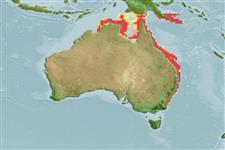Environment: milieu / climate zone / depth range / distribution range
Ecologie
marien; brak water benthopelagisch; diepte 1 - 40 m (Ref. 86942). Tropical; 9°S - 37°S, 129°E - 155°E (Ref. 114953)
Western Central and Southwest Pacific: endemic to eastern and northern Australia (Ref. 114953).
Grootte / Gewicht / Leeftijd
Maturity: Lm ? range ? - ? cm
Max length : 130 cm TL mannelijk / geslacht onbekend; (Ref. 9840); max. gepubliceerd gewicht: 6.1 kg (Ref. 40637)
Found in mangrove swamps and estuaries (Ref. 9840). Feeds on shellfish (Ref. 6871), worms, crabs and other crustaceans (Ref. 114953). Size could possibly reach 160 cm DW (Ref. 114953). Ovoviviparous (Ref. 50449). Maturity size ca. 41 cm WD (males) and 63 cm WD (females); hatch size ca. 11 cm WD (Ref. 114953).
Levenscyclus en paargedrag
Maturiteit | Voortplanting | Paaien | Eieren | Fecunditeit | Larven
Exhibit ovoviparity (aplacental viviparity), with embryos feeding initially on yolk, then receiving additional nourishment from the mother by indirect absorption of uterine fluid enriched with mucus, fat or protein through specialised structures (Ref. 50449). Distinct pairing with embrace (Ref. 205).
Mould, B., 1994. A world list of rays. The scientific nomenclature and distribution of the recent Batoidea (Batoidea, Elasmobranchii, Chondrichthyes). University of Nottingham, [UK]. 82 p. (Ref. 8630)
Status op de Rode Lijst van het IUCN (Ref. 130435: Version 2024-1)
Gevaar voor de mens
Harmless
Gebruik door de mens
Visserij: van minder commercieel belang; sportvis: ja
Tools
Speciale rapporten
Download XML
Internetbronnen
Estimates based on models
Preferred temperature (Ref.
123201): 26.9 - 29, mean 28 °C (based on 130 cells).
Fylogenetische diversiteitsindex (Ref.
82804): PD
50 = 0.5010 [Uniqueness, from 0.5 = low to 2.0 = high].
Bayesian length-weight: a=0.00468 (0.00195 - 0.01123), b=3.12 (2.92 - 3.32), in cm total length, based on LWR estimates for this (Sub)family-body shape (Ref.
93245).
Trofisch niveau (Ref.
69278): 3.6 ±0.50 se; based on food items.
Weerstandsvermogen (Ref.
120179): laag, minimale populatieverdubbelingstijd 4,5-14 jaar (Assuming fecundity<100).
Fishing Vulnerability (Ref.
59153): Very high vulnerability (78 of 100).
